Civil Technology Construction Grade 12 Questions - NSC Exams Past Papers and Memos September 2019 Preparatory Examinations
Share via Whatsapp Join our WhatsApp Group Join our Telegram GroupREQUIREMENTS:
- ANSWER BOOK
- Drawing instruments
- A non-programmable pocket calculator
INSTRUCTIONS AND INFORMATION
- This question paper consists of SIX questions: TWO questions are generic and FOUR questions are subject specific.
- Answer ALL the questions.
- Answer each question as a whole. Do NOT separate subsections of questions.
- Start the answer to EACH question on a NEW page.
- Do NOT write in the margins of the ANSWER BOOK.
- You may use sketches to illustrate your answers.
- Write ALL calculations and answers in the ANSWER BOOK or on the attached ANSWER SHEET.
- Use the mark allocation as a guide to the length of your answers.
- Make drawings and sketches in pencil, fully dimensioned and neatly finished off with descriptive titles and notes to conform to the SANS/SABS Code of Practice for Building Drawings.
- For the purpose of this question paper, the size of a brick should be taken as 220 mm x 110 mm x 75 mm.
- Use your own discretion where dimensions and/or details have been omitted.
- Answer QUESTION 2.2 on the attached ANSWER SHEET using drawing instruments where necessary.
- Write your NAME on the ANSWER SHEET and hand it in with your ANSWER BOOK, whether you have answered the question or not.
- Due to electronic transfer, drawings in the question paper are NOT to scale.
QUESTIONS
QUESTION 1: SAFETY, OHSA AND MATERIALS (GENERIC)
Start this question on a NEW page.
1.1 What is the maximum height of a trestle scaffold? (1)
1.2 Building rubble should never be dropped from elevated areas. Name the correct method of disposing rubble from elevated areas. (2)
1.3 Briefly motivate why a construction site must be suitably cordoned off. (2)
1.4 Choose the correct answer from those in brackets with regards to the construction process of stairs:
1.4.1 Stairways must be installed at least (30° / 25°) from the horizontal platform and not more than (45° / 50°) from a wall. (2)
1.4.2 Stairways that will not be a permanent part of the building construction must have landings of at least (760 x 560 mm / 750 x 600 mm) for every (3,7 m / 2,5 m) or less vertical rise. (2)
1.5 FIGURE 1.5 shows a ladder that is placed against a wall. What is the correct measurement at A to keep it stable? Show or indicate how to achieve the ratio. 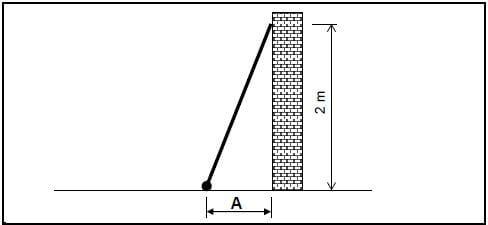
FIGURE 1.5 (2)
1.6 Explain the safety requirements when extending a ladder. (2)
1.7 Briefly explain the electroplating process of metals. (2)
1.8 Name THREE advantages of electroplating metals. (3 x 1) (3)
1.9 Name TWO advantages of galvanising metals. (2 x 1) (2) [20]
QUESTION 2: GRAPHICS, JOINING AND EQUIPMENT (GENERIC)
Start this question on a NEW page.
2.1 Indicate if the following statements, regarding site plans, are TRUE or FALSE. Write only ‘true’ or ‘false’ next to the question number in your ANSWER BOOK.
2.1.1 Scale 1 : 10 is used (1)
2.1.2 Ground contours are shown (1)
2.1.3 Layout of sewage is shown (1)
2.1.4 The proposed work is indicated in red (1)
2.1.5 Floor finishing of rooms are shown (1)
2.2 FIGURE 2.2 on ANSWER SHEET A shows an incomplete floorplan of a flat to scale 1 : 100. Complete the floorplan by using the following information:
2.2.1 Outside door at 2.2.A (2)
2.2.2 Window at 2.2.B (2)
2.2.3 Water closet at 2.2.C (2)
2.2.4 Washbasin at 2.2.D (2)
2.2.5 Wash tub at 2.2.E (2)
2.2.6 One-way switch single pole at 2.2.F (2)
2.2.7 Fluorescent light at 2.2.G (2)
2.2.8 Socket outlet at 2.2.H (2)
2.2.9 Grease trap at 2.2.I (2)
2.2.10 Wall-mounted light at 2.2.J (2)
2.3 Identify the different types of bolts in FIGURES 2.3.1, 2.3.2 and 2.3.3.  (3)
(3)
2.4 Answer the following questions on the tool in FIGURE 2.4. 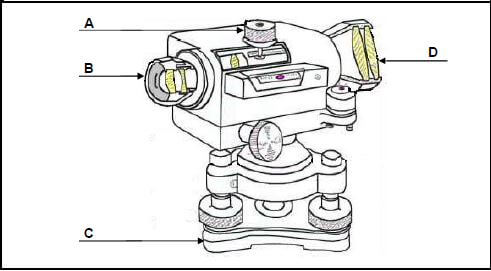
FIGURE 2.4
2.4.1 Identify the tool in FIGURE 2.4. (1)
2.4.2 Name ONE use of this tool. (1 x 1) (1)
2.4.3 Name the different parts A–D. (4 x 1) (4)
2.4.4 Name TWO uses of a laser level. (2)
2.5 Explain why the laser level should not be stored in extremely cold areas. Refer to the moisture inside the tool. (2)
2.6 Explain the meaning of the following code for Rawl bolts: M08/25. (2) [40]
TOTAL SECTION A: 60
QUESTION 3: ROOFS, STAIRCASES AND JOINING (SPECIFIC)
Start this question on a NEW page.
3.1 Identify the correct answer between brackets, e.g. 3.1.5 Purlin.
3.1.1 The slope of a (flat roof / double-pitched roof) is less than 10°. (1)
3.1.2 The (pitched roof / mono-pitched roof) slopes in one direction. (1)
3.1.3 The maximum spacing between roof trusses is (760 mm / 1 400 mm) when using corrugated iron sheets. (1)
3.1.4 The size of purlins is (38 x 38 mm / 50 x 76 mm) when using concrete roof tiles. (1)
3.2 Name THREE requirements that roof trusses should meet. (3)
3.3 Name THREE advantages of the use of roof underlays. (3)
3.4 Answer the following questions in regard to the roof truss in FIGURE 3.4. 
FIGURE 3.4
3.4.1 Identify the type of roof truss. (1)
3.4.2 Name parts A–D. (4)
3.4.3 What is a suitable span for this roof truss? (1)
3.4.4 What are the measurements (sizes) of part E? (2)
3.5 Name TWO types of material from which staircases can be made. (2)
3.6 Make a neat sketch of a typical step in the ANSWER BOOK. Show with labels the tread / going and the riser. (4)
3.7 What is the minimum headroom (height) at staircases, from the pitch line to the ceiling? (1)
3.8 What is the maximum spacing of balusters that hold the handrail at staircases? (1)
3.9 Explain ONE method of joining the following materials:
3.9.1 Roof trusses to a brick wall (1)
3.9.2 Wall plate to a brick wall (1)
3.9.3 Metal to another metal (1)
3.9.4 Metal to concrete (1) [30]
QUESTION 4: MATERIAL, EXCAVATIONS, EQUIPMENT AND TOOLS (SPECIFIC)
Start this question on a NEW page.
4.1 Choose a description from COLUMN B that fits best with an item in COLUMN A. Write only the letter (A–H) next to the question number (4.1.1–4.1.6) in the ANSWER BOOK, e.g. 4.1.7 K.
| COLUMN A | COLUMN B |
4.1.1 Slump test |
|
(6 x 1) (6)
4.2 Name FOUR types of apparatus used for the slump test. (4)
4.3 Discuss the purposes of the cube test. (2)
4.4 Draw a neat sketch of a normal failure of the cube test in the ANSWER BOOK. (3)
4.5 Discuss the purposes of cladding of the external surfaces of buildings. (3)
4.6 Name TWO methods of fixing cladding. (2)
4.7 Name THREE safety factors and regulations that a site manager must have in place, before excavation may commence. (3)
4.8 Discuss the safety precautions during excavations with reference to the following:
4.8.1 Safeguarding of excavations (1)
4.8.2 Wearing of protective clothing (1)
4.8.3 Access to a deep excavation (1)
4.8.4 Carrying out inspections (1)
4.9 Identify the following statements as TRUE or FALSE:
4.9.1 Bracing is necessary where trenches are deeper than 1,5 metre. (1)
4.9.2 Benching can help prevent the sides of trenches from collapsing. (1)
4.9.3 Machinery must be two metres from the trench during excavations. (1)
4.9.4 Excavated soil must be 1,6 metres from trench edges. (1)
4.10 Answer the following questions in regard to the shuttering in FIGURE 4.10. 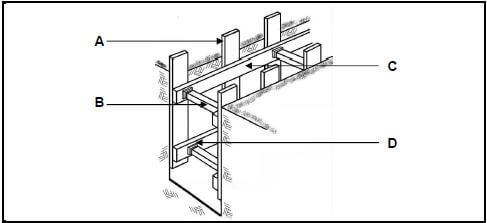
FIGURE 4.10
4.10.1 Identify the type of soil in FIGURE 4.10. (1)
4.10.2 Name parts A–D. (4)
4.11 Answer the following questions about the construction machine in FIGURE 4.11. 
FIGURE 4.11
4.11.1 Identify the machine. (1)
4.11.2 Name THREE ways of maintaining the machine. (3) [40]
QUESTION 5: BRICKWORK, GRAPHICS, PLASTER AND SCREED (SPECIFIC)
Start this question on a NEW page.
5.1 Answer the following questions about the wall construction in FIGURE 5.1. 
FIGURE 5.1
5.1.1 Identify the type of wall construction. (1)
5.1.2 What is the width of the wall? (1)
5.1.3 Name THREE purposes of the gap in the wall. (3)
5.2 Choose ONE term out of the list below for EACH of the following descriptions. Write only the term next to the question number (5.2.1–5.2.5) in the ANSWER BOOK, for example: 5.2.6 Wall plate.
| sub-base; air bricks; bedding sand; pavements; bitumen; weep hole; jointing; subgrade; walkways; wall ties |
5.2.1 The final layer upon which the paving units are laid (1)
5.2.2 Moist in a wall can escape through this (1)
5.2.3 The best edge restraint for kerbs (1)
5.2.4 Placed in the bottom course of the external walls in very wet regions (1)
5.2.5 The natural soil on which the paving will be laid (1)
5.3 Answer the following in regard to the wall tie in FIGURE 5.3. 
FIGURE 5.3
5.3.1 Identify the type of wall tie. (1)
5.4 Name FOUR advantages of dry-laid paving. (4)
5.5 Name TWO reasons for construction failure of paving. (2)
5.6 Draw a neat partial sketch of the herringbone paving pattern in the ANSWER BOOK. (3)
5.7 Name THREE advantages of beam-filling. (3) 5.8 Identify the following statements as TRUE or FALSE.
5.8.1 Beam-filling must be on the same height as the purlins. (1)
5.8.2 The central stone in an arch is called the bat brick. (1)
5.8.3 The lagging or profile of an arch wall is made from wood. (1)
5.9 Answer the following questions about the arch structure in FIGURE 5.9. 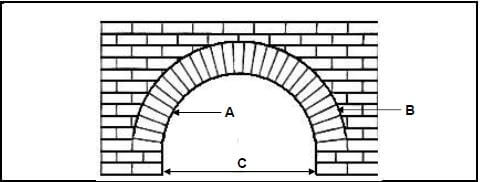
FIGURE 5.9
5.9.1 Identify the type of arch. (1)
5.9.2 Name the parts A–C. (3)
5.10 Name the ingredients of plaster (water and lime excluded). (2)
5.11 Name ONE purpose of builder’s lime in a plaster mixture. (1)
5.12 Name TWO purposes of interior plasterwork. (2)
5.13 Name ONE purpose of a screed layer. (1)
5.14 Draw the symbols of the following:
5.14.1 Electricity meter (2)
5.14.2 Water meter (2) [40]
QUESTION 6: FORMWORK, REINFORCING, FOUNDATIONS, CONCRETE FLOORS AND QUANTITIES (SPECIFIC)
Begin this question on a NEW page.
6.1 Name ONE material that can be used to line the formwork, to obtain a smoother finish of the concrete. (1)
6.2 Answer the following with regard to the formwork in FIGURE 6.2. 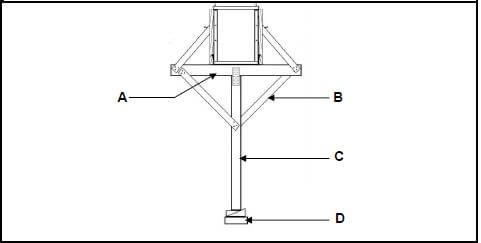
FIGURE 6.2
6.2.1 Name the parts A–D. (4)
6.3 Answer the following in regard to the bar code: 16R10-02-200
6.3.1 What type of steel is used? (1)
6.3.2 What is the spacing of the bars? (1)
6.3.3 What is the diameter of the bars? (1)
6.4 What forces are being counteracted by the following parts in concrete beam:
6.4.1 Anchor bars (1)
6.4.2 Stirrups (1)
6.5 Name ONE method of joining steel bars with wire. (1)
6.6 Name TWO purposes of the cover depth at the reinforcing of concrete work. (2)
6.7 Name TWO types of pile foundations. (2)
6.8 Name THREE reasons for the use of pile foundations. (3)
6.9 Answer the following questions in regard to the concrete floor in FIGURE 6.9. 
FIGURE 6.9
6.9.1 Name parts A–B. (2)
6.9.2 Name ONE disadvantage of this type of floor construction. (1)
6.10 FIGURE 6.10 shows a foundation strip for an outside room.
The foundation is 700 mm wide and 200 mm thick.
Answer the following questions in the ANSWER BOOK. 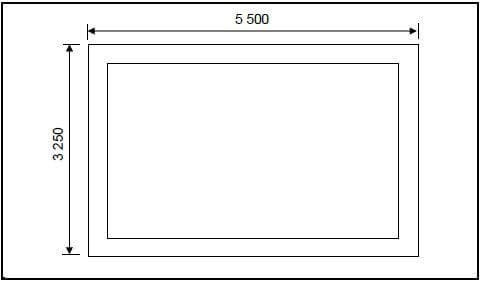
6.10.1 Calculate the centre-line of the foundation. (5)
6.10.2 Calculate the volume of concrete required. (4) [30]
TOTAL: 200
ANSWER SHEET A | CIVIL TECHNOLOGY GENERIC | NAME: |
2.2 Use the information on ANSWER SHEET A and complete the floor plan to scale 1 : 100. 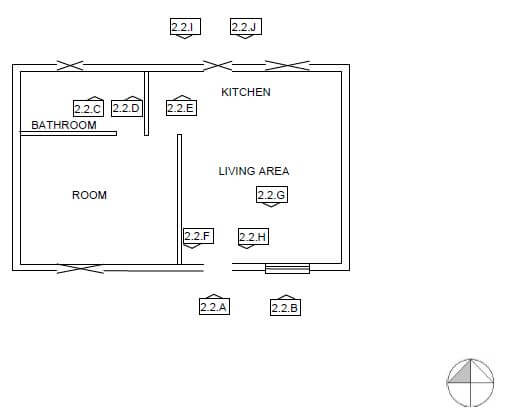
Outside door at 2.2.A | 2 | |
Window at 2.2.B | 2 | |
Water closet at 2.2.C | 2 | |
Washbasin at 2.2.D | 2 | |
Wash tub at 2.2.E | 2 | |
One-way switch single pole 2.2.F | 2 | |
Fluorescent light at 2.2.G | 2 | |
Socket outlet at 2.2.H | 2 | |
Grease trap at 2.2.I | 2 | |
Wall-mounted light at 2.2.J | 2 | |
TOTAL: | 20 |